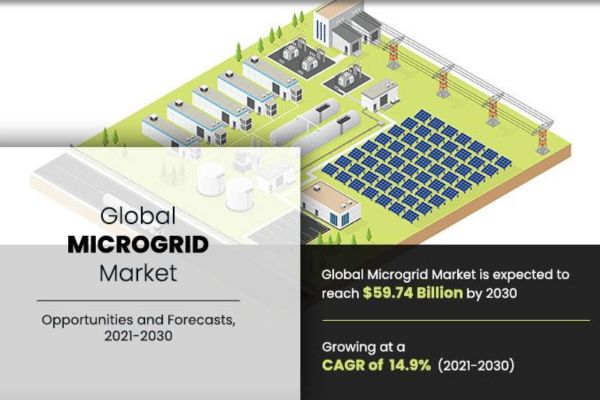A microgrid is a localized, small scale energy system that can operate independently or in conjunction with the main power grid. It integrates various distributed energy resources, such as solar panels, wind turbines, batteries, and generators, to generate, store, and distribute electricity. Microgrids enhance resilience, reliability, and sustainability by providing decentralized power solutions for communities, businesses, or campuses. They offer flexibility and can operate autonomously during grid outages, promoting energy security and efficiency.
Microgrids find diverse applications in various sectors, providing localized and resilient energy solutions for residential, commercial, industrial, community, military, healthcare, educational, remote, and emergency settings. It is because microgrids offer an array of benefits such as improved energy efficiency, reduced carbon footprint, and enhanced energy security. As renewable energy sources become more integrated, microgrids play an important role in balancing intermittent power generation.
Microgrid integration is a complex process that requires careful planning, design, and implementation to achieve a resilient and efficient energy infrastructure. It involves coordination of various components to create a reliable and efficient energy system. Here are key aspects of microgrid integration –
- Energy sources –
Renewable resources – microgrids often incorporate renewable energy sources like solar panels and wind turbines, promoting sustainability and reducing reliance on traditional power grids.
Backup generators – fossil fuel-based generators or other backup power sources can be integrated to ensure continuous energy supply during periods of low renewable generation.
- Energy storage –
Batteries – energy storage systems, typically using batteries, store excess energy during times of surplus and release it during high demand or when renewable sources are unavailable, improving overall grid stability.
- Control systems –
Advanced control algorithms – microgrid controllers manage and optimize the operation of diverse energy sources and storage, making real time decisions to balance supply and demand.
Grid synchronization – microgrids can operate independently or synchronize with the main grid, enabling them to exchange power based on demand, grid conditions, or economic considerations.
- Distributed energy resources (DERs) –
Smart inverters – inverters play a crucial role in converting DC power from solar panels into AC power. Smart inverters enable communication and coordination between different energy sources for optimal performance.
Grid forming inverters – these inverters can create a stable grid, allowing microgrids to operate autonomously without relying on a connection to the main grid.
- Monitoring and analytics –
Sensor networks – sensors monitor various parameters like energy production, consumption, and grid stability, providing real time data for efficient decision making.
Predictive analytics – advanced analytics help forecast energy demand, optimize resource utilization, and plan for maintenance, enhancing overall system performance.
- Islanding capability –
Autonomous operation – microgrids can isolate themselves from the main grid during outages, allowing them to operate independently and provide continuous power to critical loads.
- Grid interconnection standards –
Interoperability – adherence to industry standards ensures seamless communication and compatibility between different components, facilitating integration and interoperability.
- Cybersecurity measures –
Secure communication protocols – robust cybersecurity measures protect microgrid components from potential cyber threats, ensuring the integrity and reliability of the energy system.
Internet of Things (IoT) in microgrids is important for real time monitoring, automated control, fault detection, load balancing, predictive analytics, remote management, energy trading, cybersecurity, enhanced communication, and efficient energy management. It enhances grid resilience, facilitates predictive maintenance, enables remote management, and supports secure energy transactions, making microgrids smarter, more responsive, and adaptable to dynamic energy needs.
According to a report published by Allied Market Research, the global microgrid market size is registered to reach $59.74 billion with a considerable CAGR from 2021 to 2030. The Asia-Pacific region is expected to witness the fastest growth rate during the forecasted period. A combination of factors including surge in adoption of ruggedized computers and rise in development of smart cities are driving the market growth.
In addition, the increasing focus on renewable energy sources, such as solar and wind, is boosting the microgrid industry. Microgrids facilitate the seamless integration of these intermittent sources into the energy mix, enhancing overall sustainability.
Moreover, the need for energy security, especially in regions prone to power disruptions, is a significant driver. Microgrids provide a level of independence from centralized grids, reducing the impact of system wide failures.
At the same time, continuous advancements in control systems, energy storage, and smart grid technologies play a pivotal role in the growth of the global microgrids market. Improved efficiency and cost effectiveness make microgrids more attractive. In a nutshell, the microgrid industry is driven by various environmental, technological, and socio-economic factors, making it an essential player in the evolving landscape of the energy sector.
In the meantime, Advanced Power and Energy Program (APEP) in collaboration with Southern California Edison (SCE) is focusing on the development, deployment, and testing of two microgrid communities. More such initiatives are contributing to the growth of the market.
Furthermore, government initiatives and policies supporting clean energy and grid modernization drive the adoption of microgrid solutions. With this drift on board, the future of the global microgrid industry looks bright, involving continuous expansion, technological innovations, increasing renewable energy integration, and a global push towards sustainable and resilient energy infrastructure.















